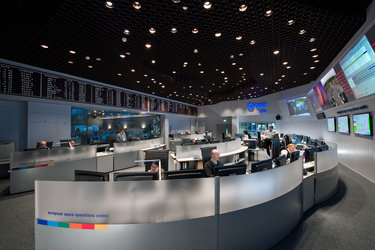Sentinel-5P: satellite in excellent health
Launched last week, Europe’s Sentinel-5P satellite – the first Copernicus mission dedicated to monitoring the air we breathe – is in excellent health.
The 820 kg satellite was lofted into orbit from the Plesetsk Cosmodrome in northern Russia last Friday on a Rockot.
The satellite will use its state-of-the-art Tropomi instrument to monitor our atmosphere, mapping a multitude of gases that affect the air we breathe, our climate and human health.
After separating from the upper stage at an orbital speed of around 27 000 km/h, Sentinel opened its three solar panels and began communicating with Earth.
The first signal was received 93 min after launch as it passed over the Kiruna station in northern Sweden.
Critical early days
Contact meant that engineers at ESA’s mission control in Darmstadt, Germany, could assume control of the satellite, and begin working around the clock to check its condition and start setting it up it for routine flight.


Access the video
The satellite is on solar power, its navigation and communication systems are operating as expected and it is fully functional after its raucous ride into space.
“Sentinel-5P is in excellent health and we were a little ahead of schedule in the timeline for the first three days,” says spacecraft operations manager Daniel Mesples.
“That meant we could reduce our 24 hours-a-day schedule a little earlier than planned and declare that the initial phase was complete by Saturday evening.
“As of today, we’re back to working daytime hours. Everything is going very well.”
Preparing for the sniffing phase
The good news means the satellite is ready for the next crucial phase: commissioning the Tropomi atmosphere sensor over the next six months.


Access the video
Once in service, it will map the entire planet every day for Europe’s Copernicus Atmosphere Monitoring Service air quality forecasts and for decision-making.
It is the first Copernicus mission dedicated to monitoring our atmosphere. It follows a fleet of five other Sentinels already in orbit and delivering a wealth of information about our planet.
The Sentinels make up the core of the space component of the EU’s Copernicus environmental monitoring network.
An EU flagship space initiative, Copernicus provides timely operational information on the world’s land surfaces, oceans and atmosphere to support environmental and security policymaking, and meet the needs of citizens and service providers.

“The satellite completed its initial critical orbital activities in just about 33 hours, a record, and this time there were no surprises,” says Paolo Ferri, head of mission operations at ESA.
“This is a testament to the quality of the satellite builders and the expertise of the mission control team, mixed with the necessary bit of luck.
“Given the complexity of spaceflight and the factors that can’t be fully predicted, we can’t always count on this, but we are happy when it does happen.”













 Germany
Germany
 Austria
Austria
 Belgium
Belgium
 Denmark
Denmark
 Spain
Spain
 Estonia
Estonia
 Finland
Finland
 France
France
 Greece
Greece
 Hungary
Hungary
 Ireland
Ireland
 Italy
Italy
 Luxembourg
Luxembourg
 Norway
Norway
 The Netherlands
The Netherlands
 Poland
Poland
 Portugal
Portugal
 Czechia
Czechia
 Romania
Romania
 United Kingdom
United Kingdom
 Slovenia
Slovenia
 Sweden
Sweden
 Switzerland
Switzerland





































